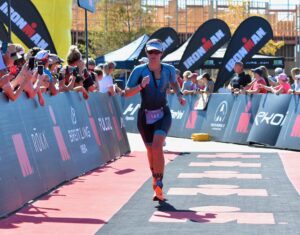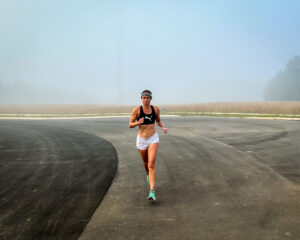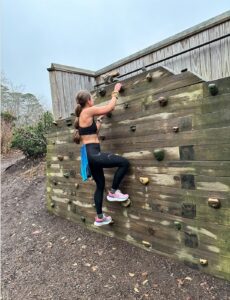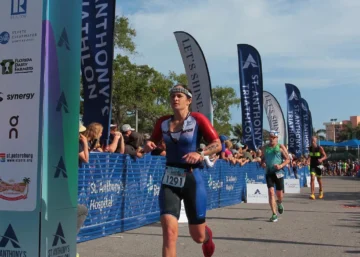
I’ve been an athlete for my entire life. When I was younger, I did tennis, soccer, softball, cheerleading, karate, and horseback riding. But I hadn’t done anything that required any real aerobic fitness, until I started running in 2019.
Now, I’m beginning my sixth year of triathlon, and running, because I started doing both around the same time. That isn’t a problem per say, except that it meant when I started competing in triathlon, I hadn’t been running long enough to develop any aerobic base. I just started racing.
I never really understood why aerobic training was so important until I had to write an article about it for Triathlete Magazine. Click here to read.
Basically, the word aerobic means “with oxygen.” When you’re exercising in an aerobic zone, the heart is working easy enough that it’s able to deliver oxygenated blood to the muscles. You might hear it called it Zone 2 or your “conversational pace.”
On the other hand, there’s anaerobic, which means “without oxygen.” This type of workout involves short, intense activity. You know the kind where you can’t breathe, your legs are burning, and your heart rate is sky high?
Both aerobic and anaerobic exercise are important, but the reason why aerobic is so important is that having a strong aerobic base will allow an athlete to go longer, and faster, at a sustainable effort.

Me at 2022 North Carolina 70.3, my fastest race yet (running definitely not aerobic here)
Back to me: when I started doing triathlon, I had no aerobic base to speak of. So I became very good at being an inefficient runner. I could run fast, but only for short periods of time, because I didn’t have a big heart rate range to work with. It seemed like once I started running, no matter how slowly, I was automatically in Zone 3 (that’s not aerobic), so by the time I’m racing, I’m already in Zone 4.
I’m not a coach, so I won’t get too technical, but Training Peaks has a common calculation for determining heart rate zones.
- Zone 1: Recovery- less than 85% lactate threshold
- Zone 2: Aerobic- 85-89%
- Zone 3: Tempo- 90-94%
- Zone 4: Sub-threshold- 95-99%
For someone who primarily races 70.3’s, with some sprint and Olympic distance triathlons thrown in there for fun, I can’t always be in Zone 4 right off the bat. It’s just not sustainable for a longer distance race.
This is something my coach definitely noticed, so in 2022, we did a big aerobic run block during the off-season. That basically consists of doing a lot of running at a low heart rate.
That should be super easy, right? You just run slow all the time. Actually, it can be incredibly frustrating, especially if you haven’t paid much attention to your heart rate before. Back then, I was given a threshold of 164. That was the number I had to keep my heart rate under in order to stay “aerobic.” Keep it under 164. No matter what.
That meant if I was running up hills, or in the heat, I had to walk a few steps (or a lot of steps) to keep my heart rate down. Sometimes, it barely felt like I was running at all.
 We started out by doing several 2-mile runs every other day, which then progressed to 3-mile runs several times a week. Eventually, I was able to incorporate back in some intensity by running hills and doing intervals.
We started out by doing several 2-mile runs every other day, which then progressed to 3-mile runs several times a week. Eventually, I was able to incorporate back in some intensity by running hills and doing intervals.
When I started the process, I could barely run a 10:30- 10:15 min/mile and stay aerobic. For frame of reference, I’m not the fastest runner, but I’m certainly not slow either. I can do a 7:30 min/mile for a 5K. So if I have to run 10:30-10:15 min/mile just to stay aerobic, that doesn’t help me out much from a racing standpoint. I needed to grow my aerobic base.
The training block could’ve been 8 or 12 weeks, (I can’t remember anymore) but at the end of the process something amazing thing happened. I could consistently run a 10:00- 9:45 min/mile and stay aerobic! It might not sound like a big difference, but changing that lower zone meant that all my other zones changed as well, and I was able to run faster at the same effort.
Something else interesting happened. I actually started enjoying running. There wasn’t any pressure. I wasn’t constantly checking pace on my watch, and the effort was easier, so it made running more enjoyable. I ran on my favorite trails and listened to the birds chirp in the sunshine, and I was happy. And then race season started again. But it was nice while it lasted.

Taking a break during an aerobic run to climb the rock wall!
All this to say, I’m doing it again! At the start of each off-season, my coach and I get together and pick something to work on. I always end up picking a running-based goal, because that’s the sport I have the least experience in.
As I mentioned in my last post, I’m tantalizingly close to running my stand-alone half marathon time at the end of a 70.3, so that’s something I’m working towards. To achieve that means I need to put in another aerobic run block.
Again, that means a lot of running, this time at a VERY low heart rate. How low? The threshold I now have to keep it under is 145. How did we get that number? No idea. Ask my coach. It probably has something to do with the running time trial I did in November after IM FL.
All you need to know is 145 is low, very low, (for me) which means I have to run slow, very slow. But, it’s ok, because this time I know what I’m in for.
Granted, it’s not super exciting stuff, but it pays off big time if you’re disciplined enough to stick with it. I’m about seven weeks in at this point, and this time around I’m actually starting to see changes during the block. When I started, staying under 145 meant running an 11:00-11:15 min/mile. Now, I’m around 10:45-10:50 min/mile, which is exciting to see.
But it’s hard. Not necessarily physically hard, but mentally hard. You start looking at that pace on your watch and questioning everything in life.
“Why am I running so slow?”
“Shouldn’t I be running faster?”
“Does this mean I’ve lost all my fitness?”
“I’m certain. I’ve lost all my fitness. I’m slow now, and I will never run fast again!”
(My internal running monologue is a bit dramatic.)
It takes a lot of commitment and dedication to do something that isn’t necessarily fun in the moment, but that you know will pay big dividends in the future. Since I’ve done this before, I have a few tips that have helped me keep my sanity while doing aerobic running.
#1- Don’t look at pace- Seriously, turn it off. I make a separate screen on my watch that only shows heart rate. I don’t look at pace at all, because it’s just going to irritate me. It doesn’t matter anyways, because all I need to see is heart rate, mileage, and time.
#2- Pay attention to breathing– This is something I’ve had to work on a lot. During aerobic running, you quickly realize how much your breathing affects heart rate. If I start daydreaming and I’m not focused on my breathing, my heart rate will jump up a few beats, and I have none to waste. This is especially true when running uphill. I do a 1-2-hold breathing pattern when running uphill. So, two quick inhales, followed by a half second hold, and then exhale to help lower my heart rate.
#3- Sometimes you have to walk- Just accept it. It’s likely that at some point in time you’re going to have to walk, whether it’s because you started out a bit dehydrated, it’s hot, you’re running uphill, or your heart just isn’t cooperating that day. It’s crucial to stay in the correct zone in order for the adaptation to work, so I just walk 15-30 steps, chill out, and start running again.
#4- Ignore Strava- “I can’t run slow. Then, people will think I’m slow.” Here’s a secret: nobody cares what you’re doing. They only care what other people think about their workouts.
#5- Stick with it- And try to have some fun along the way. You’re doing something that’s going to make you a better athlete down the road, so let your present self do something amazing for your future self that your past self will be so glad you did.


